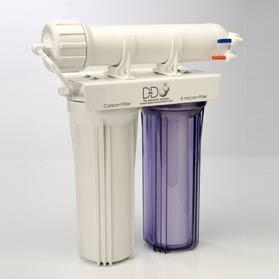What is Reverse Osmosis?
Osmosis is the flow of water from a region of low salt concentration to a region of high salt concentration through a semi permeable membrane.
In other words if two containers of water, one at high salt concentration and one at low salt concentration were connected by a semi permeable membrane then the water molecules would flow from the low concentration to the high concentration until both solutions were balanced out.
This is of course of no benefit to the aquarist.
However if a pressure is applied to the region of the high salt concentration it will force the water molecules from the high concentration region through the membrane, against the tendency for osmotic flow. Hence the name reverse osmosis.
If taken to the extreme this would ultimately result in one container being full of pure water and the other containing all of the salt.
R O membranes
Mdern RO membranes consist of a tightly wound osmotic film forming a cartridge which uses the pressure of the incoming mains water to force the pure water into a central tube for collection.
Most TFC (thin film composite) membranes produce water with a 90-98% plus rejection of the salts depending on the temperature and pressure and the particular salt.
What is the benefit of RO water to the aquarist
The benefit of RO water is that the majority of the detrimental salts and ions that normally pollute our water supplies such as nitrate or phosphate are effectively removed which allows us far more control of these substances in the aquarium as we are not adding them during water changes.
Pre-filters and carbon filters also remove solids and chlorine from the mains supply to give you the best starting point for start up water and for regular water changes. This helps greatly to reduce the growth of nuisance algae that would normally feed on the nitrates and phosphates in your system.
